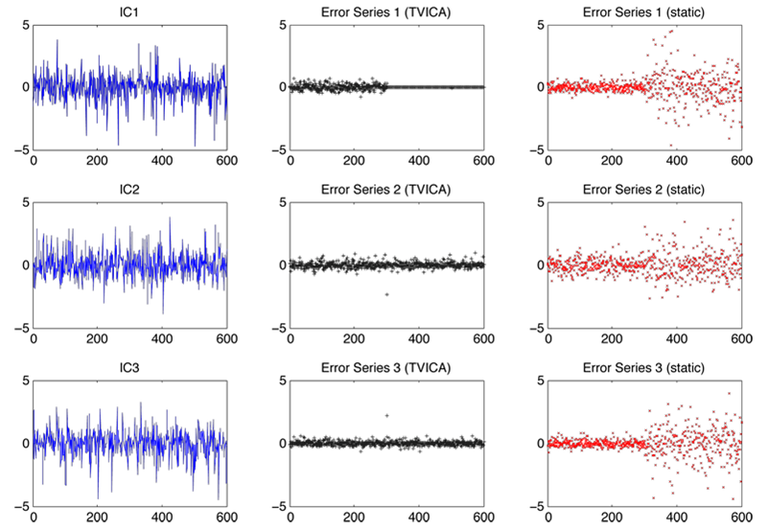B1 - Dynamic factor models
Statistical modelling for dynamic economic, finance and weather data in high dimensions requires a balanced combination of flexibility, interpretability and numerical tractability. Dimension reduction techniques for functional data analysis model and approximate smooth random functions by lower dimensional objects. The most prominent dimension reduction technique, Functional Principal Components Analysis, combines PCA and dimension reduction with pre-smoothing for effective dimensional space at fixed time horizon. In many applications the focus of interest lies not only in dimension reduction but also in the dynamic behaviour of the lower dimensional objects. Dynamic Semiparametric Factor Models (DSFM) simultaneously reduce dimensionality avoiding preliminary smoothing and consider the time structure of unknown random functions by means of inference based on their lower dimensional representation with flexible basis structures: the unknown nonparametric factors (Fengler et al., 2007; Park et al., 2009). The DSFM nests linear models which allow for time varying coefficients as a special case, such as Fan et. al (2007) or Yang et al. (2006). The main result is that one may proceed in inferential testing with the estimated factor loading process and does not need to know the (unobservable) time series. The choice of basis functions have been dealt with in Song et al. (2011) where also variable selection techniques are discussed.
A high-dimensional generalised varying coefficient regression model has been presented in Lee et al. (2011). An open question still is the choice of basis functions and other dimensionality parameters (e.g. bandwidth) in practical applications. The basis functions could, for example, include the shift, slope and twist as basic elements. In many situations the coefficients of the basis functions need to be constrained in order to allow for structural forms. Generalizations of the DSFM need to be studied Penalizations, such as LASSO (Least Absolute Shrinkage and Selection Operator) or SCAD (smoothly clipped Absolute Deviation), and more general convex contrasts (Bradic et al., 2011) will overcome the problem of overfitting. Furthermore we would like to analyse asymptotics of semiparametric factor dynamics and show that the difference of the inferences based on the estimated factor and the true factor is asymptotically negligible.
Coordination
- Nikolaus Hautsch: His main interests are in Econometric models and Empirical Finance. His recent research concentrates on linear and nonlinear time series models, latent factor models, econometrics for financial transaction data, market microstructure analysis, information processing and analysis of limit order book markets.
- Muyi Li: Her research interests are Time series analysis, high dimensional financial econometrics, model specification tests and diagnostic checkings.
- Brenda López-Cabrera: Her research interests are portfolio optimization, empirical and computational finance and applications within the field of statistical analysis of insurance, finance and energy. She concentrates on economic risk of natural hazards and focuses on Catastrophe Bonds, Weather and Energy Markets.
- Yu Ren: His main interests are Financial Econometrics, Applied Econometrics, Econometric Theory. His research includes work on testing of stochastic discount factor and China finance.
- Mengmeng Guo: Her research interests are dimension reduction techniques, such as dynamic factor models or functional principal components, and multivariate statistics.
- Zongwu Cai: His main interests are Econometrics, Quantitative Finance, Nonlinear Time Series. His research includes work in Theoretical and applied econometrics, quantitative finance and risk management, nonparametric curve estimation problems, nonlinear and non-stationary time series, panel data analysis.
- Haiqiang Chen: His main interests are Financial Econometrics, Time Series Econometrics and Financial Economics. His research includes work on financial time series, structural change points detections.
- Thorsten Dickhaus: Thorsten Dickhaus is an expert in multiple testing theories, especially for high-dimensional data and with respect to control of the false discovery rate. He has also worked on low intensity bootstrap methods for problems involving non-standard test statistics. His expertise in applications comprises planning and evaluation of biometrical and epidemiological studies, analysis of genetics data, statistical neuro-science, and neuroeconomics.
- Ying Fang: His main interests are Econometrics, Applied Econometrics, Economy of China. His research includes work in nonparametric and semi-parametric method, panel data analysis, and instrumental variable selection.
- Wolfgang Härdle: His main interests are non- and semiparametrics statistics and econometrics. His research includes work in nonparametric modelling, local adaptive models, reduction techniques, stationary models, quantile regression.
- Ming Lin: His main interests are Monte Carlo Methods, self selection, dimension reduction methods. His research includes work in Monte Carlo algorithm, Bayesian statistics, nonparametric statistics.


